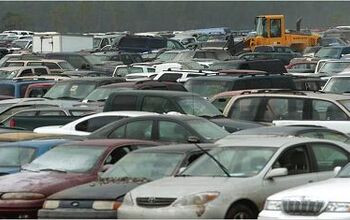Hammer Time: Is Reliability Getting Old?
“You can have any car you want. So long as it’s a Toyota or Honda.”
My parents had offered to split the costs of a new car with me back in 1994. That matching policy eventually included an awful lot of disclaimers and exclusions.
“No V8! No V6! No turbo! No stick! No convertible! No small car! No! Nein! Nyet!”
I eventually settled on a red Toyota Camry Coupe that served me well for 12 years and nearly 240k miles. It’s still on the road, which is funny because my brother, who had an equal bent on the Toyonda reliability supremacy, did something unusual recently.
He bought an Audi. Then he did something even stranger than that… he bought another.
It was a used, CPO, three year old Audi A4. Even with a few minor electric bugaboos, the car went out the door real quick. This car buying decision was highly unusual for a guy who kept up with cars and had bought nothing but new Hondas and Toyotas for nearly 30 years.
He knew all too well about the historical reliability issues with VW products. He even enjoyed the two Toyotas and one Honda he bought before going completely cold turkey on them about 10 years ago. When it came to spending that large chunk of cash on a daily driver, he crunched the numbers just like he always does on a spreadsheet, and checked off the usual must-haves.
But those numbers and wants yielded a final decision that was far different than those times of 10, 20 and even 30 years ago.
The 1984 Celica Supra. The 1994 Camry Wagon and the 2003 Honda Pilot have all given way to a 2012 Audi A6 and and a 2013 Audi A4.
I can see three big reasons why this happened.
The first is the length of warranties for used cars Certified Pre-Owned programs. The pushing of long-term warranties into the late model used car market have enabled brands that were once reliability pariahs, to become unusually competitive to today’s once untouchable reliable brands.
The removal of repair risk is a game changer for car buyers like my brother. Just as the Treasury guarantees their notes regardless of the current debt, that CPO warranty is guaranteeing the manufacturers product regardless of it’s potential repair issues. That vehicle may have thick black dots on Consumer Reports. Or even a long list of complaints about a specific mechanical issue that is a mere Google search away. It doesn’t matter, at least for right now. Because all those parts that may go south are covered to a further extent than the boring new car alternative.
The consumer’s perception of a CPO vehicle is that the warranty will make the repair costs for that sporty, fun, prestigious vehicle similar to the most drop dead boring, toaster personality, reliable competitor. Perception is often the only reality that matters in the marketplace, which is why late-model European models in particular have largely adapted a process of catering to the lease crowd first and the CPO seeking customer later.
So why buy a new boring or cheap car when a three old fun-to drive alternative offers more bang for the buck and a better warranty? For those who are used to trading or selling their car once it hits 100,000 miles, the broadened CPO programs have greatly expanded the scope of vehicles that are considered reliable enough to handle that mileage period.
The second reason for the decline of reliability based car buying, is that cars are increasingly seen as a durable goods in the marketplace. Old diesel benzes, Volvos, Toyotas & Hondas were once the gold standard for those who were seeking long-term car ownership.
Now, even the worst brands are assumed to have lifetimes well into the double digits. Some may last as long as 15 or 20 years in many parts of this country.
There is a long list of legitimate reasons why this has become the case. The institution of lean production methods. The development of polymers, petrochemicals and other materials that have longer lives and better resistance to age and wear. Even the shuttering of unprofitable brands has enabled certain manufacturers to focus more on the quality of their offerings, instead of what could kindly be called a pointless plentitude of cosmetic primpings.
There are countless honest to goodness reasons why the 10 to 15 year old car of today is seen as capable of lasting 20 years or beyond, and that psychological reality has made reliability seem to be more of a rule and less of an exception.
The final issue I will cover here (I’m sure all of you will chime in with other good ideas) is that the internet has essentially wounded the standard bearers of reliability information in the automotive industry. I can go to carsurvey.org and find over 100,000 feedbacks from folks who have actually owned and kept specific vehicles. Edmunds, Yahoo!, MSN, Kelly Blue Book, a long, long list of automotive sites that provide information to a mass audience now offer reliability information and insights for essentially nothing. Want to go deeper? There are hundreds of enthusiast sites that make the car buying experience as detail driven as you want it to become.
You don’t need to subscribe to anything. You don’t need to wonder what the real difference is between a half blackened oval and an almost fully blackened oval with a strange dot in the middle. You can read actual personal feedback from folks who have owned the specific model that interests you and if you want to learn more, just keep reading… and reading…
This access to knowledge has changed not only what people buy, but what they’re willing to spend. A young person may not have a fondness for older cars in the beginning of their search for a daily driver. But if they reads a long list of happy feedback from a brand that is defunct, or a model that is no longer sold, that consumer may just decide that the popular reliable car is not worth what could amount to a near five-figured price premium.
A 15 year old so-called beater car, at least according to the information in front of them, can do the commutes just as well as a five year old car that would put them in debt. So why not? After all, many of those older beater cars still look great, drive well, and last for the long haul.
There are a long list of reasons why reliability is becoming more of a given and less of a means to differentiate one car over another. So feel free to share your thoughts, and to those of you who offered me a Happy Birthday yesterday, thanks. I am still thankfully young in what may very well be a long, long period of middle-age.
More by Steven Lang
Latest Car Reviews
Read moreLatest Product Reviews
Read moreRecent Comments
- Mister It wasn't helped any by the horrible fuel economy for what it was... something like 22mpg city, iirc.
- Lorenzo I shop for all-season tires that have good wet and dry pavement grip and use them year-round. Nothing works on black ice, and I stopped driving in snow long ago - I'll wait until the streets and highways are plowed, when all-seasons are good enough. After all, I don't live in Canada or deep in the snow zone.
- FormerFF I’m in Atlanta. The summers go on in April and come off in October. I have a Cayman that stays on summer tires year round and gets driven on winter days when the temperature gets above 45 F and it’s dry, which is usually at least once a week.
- Kwik_Shift_Pro4X I've never driven anything that would justify having summer tires.
- Scotes So I’ll bite on a real world example… 2020 BMW M340i. Michelin Pilot Sport 4S. At 40k now and I replaced them at about 20k. Note this is the staggered setup on rwd. They stick like glue when they are new and when they are warm. Usually the second winter when temps drop below 50/60 in the mornings they definitely feel like they are not awake and up to the task and noise really becomes an issue as the wear sets in. As I’ve made it through this rainy season here in LA will ride them out for the summer but thinking to go Continental DWS before the next cold/rainy season. Thoughts? Discuss.


































Comments
Join the conversation
Every time I've looked at CPO Audis and BMWs, I've wondered why anyone would choose them over buying new, considering the minimal difference in cost. Maybe it's a regional thing. The most ridiculous one was a 3-year-old, 40k mile CPO BMW 3-series at a BMW dealer that was advertised as "$X per month for Y years". Some quick math showed that it would add up to about $30,000. Sounds about right; comparable to a private sale. Went in there for a look and they had neglected to mention the $10,000 down payment that brought the price up within a couple grand of a brand new one. I guess the fine print isn't a legal requirement on Kijiji? I just block the dealer ads on there now.
I bought a 2009 F-150 screw @ 93k km's. Blew the tranny last October @ 106k km's. Love my truck, and I hate the thought of ditching it, but the tranny is slamming, again, and although the last tranny job was covered by an aftermarket warranty, I suspect the next tranny job will be shortly after that warranty runs out. Hard to say if it's slightly related to the work I make the truck do, or just a crappy transmission design. Too bad, I really love the LSD in 4-high, being pushed by the 5.4L. Prior to that, I had a Yaris that was falling apart after just four years of extremely gentle ownership. It had absolutely ZERO redeeming driving qualities. Purely a toaster. Or meat grinder over 70mph. So you better believe I was anxious to dump it. But my truck, oh, that lovely truck and the grunt it produces when I step on it, as impractical as a commuter vehicle it may be, it's still my toy...